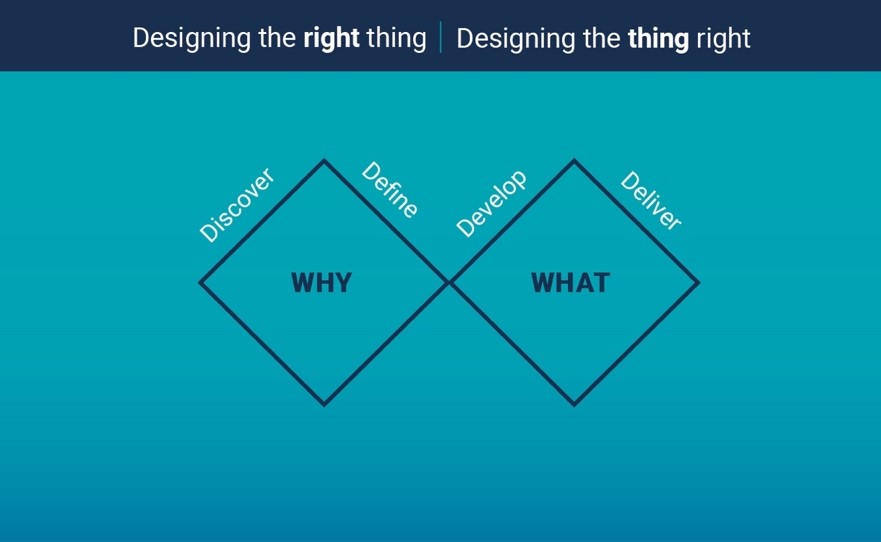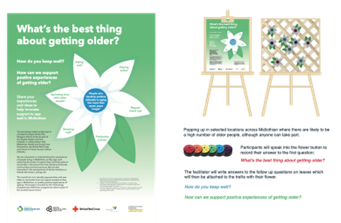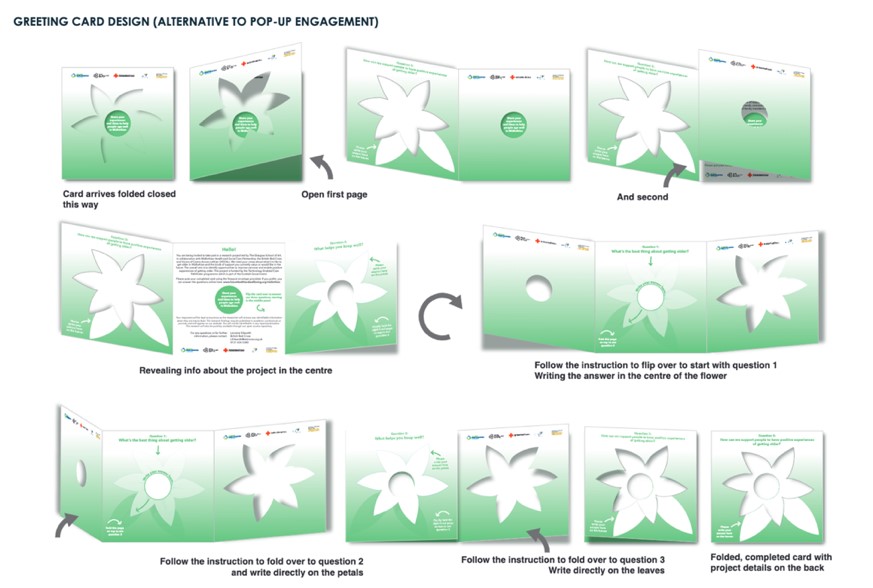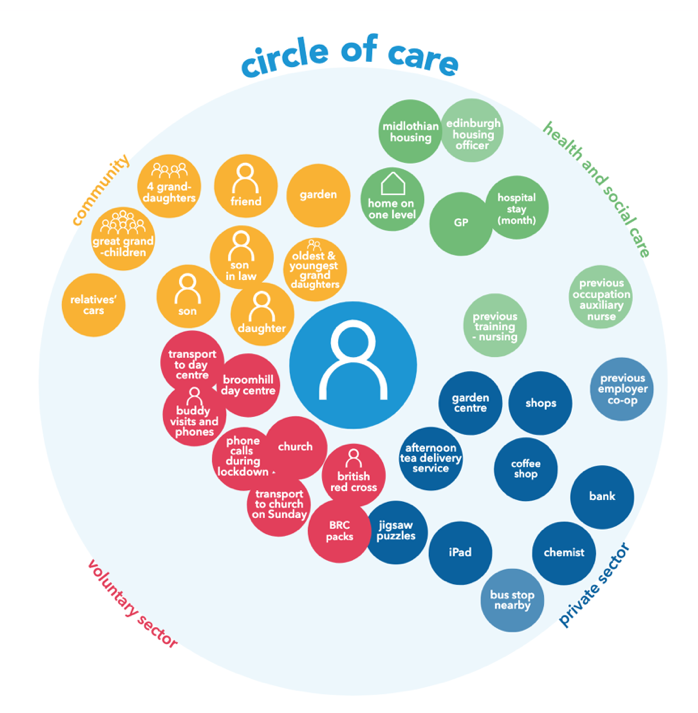Transforming Midlothian's Frailty Care System - Case Study
Transforming Midlothian’s Frailty Care System using the Scottish Approach to Service Design to achieve Technology Enabled Care
Midlothian Health and Social Care Partnership recognised that traditional models of care needed to transform to enable the increasing numbers of people living with frailty to achieve their best possible quality of life. Despite introducing a number of innovative ways to identify and support people, we recognised some continuing challenges:
- The experience of care and support for people living with frailty, their family and carers, and staff can be difficult, fragmented and full of barriers;
- Systems and pathways of care are not consistent;
- There are structural barriers between different organisations – in particular in sharing information – which get in the way of person-centred care;
- Solutions often don’t address the whole system at scale.
Engaging with citizens and professionals in this 'first diamond' of the Scottish Approach to Service Design has helped the partnership gain a far deeper understanding of the problem are originally identified. Instead of leaping in with solutions, we have been forced - sometimes uncomfortably for professionals who like to be able to identify solutions 'at pace' - to engage in the underlying causes of problems from the perspective of the user. The findings will enable us to better design a whole system of frailty care. In addition, the methodology is one that we are already adopting and adapting more widely in the partnership.
Morag Barrow, Chief Officer
The opportunity
Midlothian Health and Social Care Partnership had an opportunity to do things very differently - to properly understand the problem before leaping into solutions. We successfully applied to the Technology Enabled Care (TEC) Transforming Local Systems Pathfinder Programme at the Scottish Government. The Pathfinder programme is adopting the Scottish Approach to Service Design to transform an important aspect of services or supports (the ‘whole system’) towards prevention in each of four pathfinder areas.
The ‘Scottish Approach to Service Design’ (SAtSD) describes design as a way of exploring problems openly, collaboratively and with users, before a solution or service is decided. It aims to support and empower the people of Scotland to actively participate in the definition, design and delivery of their public services (from policy making to live service improvement).
It is a method of exploring the root cause of problems (needs) of people in a way that removes organisational or sectoral boundaries. It is way of working that brings otherwise separate parts of the public sector (and other sectors) around a common goal.
Each diamond shape illustrates the process of creating or exploring many possible ideas before refining these to the best idea. The first diamond does this to confirm the problem, and the second to design the solution.

Photo: Scottish Government - The Scottish Approach to Service Design
Who are the key partners?
The programme design stipulated this should be ‘a partnership of equals’ so that all possible talents and experiences could influence the design process. As well as people living with frailty and their carers, Midlothian Health and Social Care Partnership worked with a number of partners including:
- The Digital Health & Care Innovation Centre (DHI), a collaboration between The Glasgow School of Art and the University of Strathclyde funded by the Scottish Government and the Scottish Funding Council. They focused on enabling active participation using expertise in participatory design to engage stakeholders in reimagining the system of care.
- Local clinicians
- The Red Cross
- VOCAL (Voice of Carers Across Lothian)
How are we doing it?
We used a range of different approaches to work with stakeholder groups in the design process. We needed to understand the current system of care from different perspectives and understand how we can take a preventative approach to frailty and support self-management.
DHI co-designed the research process with the Midlothian team and co-delivered it, so that skills and learning about design were embedded within the partnership. Our project manager undertook the three day ‘Champions Course’ in the Scottish Approach to Service Design.
The stages of user research included:
Systems Mapping
Through our service mapping workshop with professionals we built up a picture of the system of care for people living with frailty from the perspectives of the many different professionals involved. This highlighted the complexity of the system and identified opportunities to support professionals and citizens to better navigate and co-ordinate care.
Observations
Researchers from DHI observed a multidisciplinary frailty meeting and a British Red Cross ‘What Matters?’ frailty assessment in a person’s home to understand how these innovations are supporting more integrated care, and how these collaborative ways of working could be enhanced.

Public Engagement
The approach to public engagement was adapted due to the COVID-19 pandemic to facilitate remote engagement using greeting cards and an online tool:

In-depth interviews
We undertook interviews remotely due to COVID-19. We preferred telephone to video calls to ensure that participants did not need IT skills or an internet connection. We used the dial out feature in the Microsoft Teams platform to enable us to undertake three-person telephone interviews, with the British Red Cross Advisor or VOCAL Advisor joined by the DHI researcher and participant.
The interview was divided into two sessions, to enable us to produce two visual maps following the first interview which were posted out to participants and used for discussion in the second interview.
The interviews uncovered insight about the support people value, their personal challenges, and the system barriers that restrict access to support. The interview maps helped people reflect during conversations about future aspirations and support they might need.

Engagement sessions with professionals
We engaged professionals from across the frailty system of care in interpreting the interview maps, with each session focusing on a different interview participant. The sessions culminated in the generation of ‘how might we...?’ questions.
The maps led professionals to reflect that how they currently tackle system challenges can often contribute to the system’s complexity. The process really helped us to cut through complexity and perceived challenges by understanding what people really need and value.
I loved the maps. It was really interesting to see my life written down in that form, you know, and it just made me realise all the different plates I've got spinning. I found it really helpful.
Interviewee participant
What is happening as a result of doing things differently?
For each of the four stages we generated ‘How might we...?’ questions to translate findings into actionable insights. The findings and ‘How might we...?’ questions generated 10 related focus areas.
The importance of system ‘navigators’ or ‘hubs’ to help overcome barriers to accessing support and help people living with frailty and carers to navigate the complexity of the health and care system was central to the findings.
We are now moving into the ‘Develop’ phase of the Scottish Approach to Service Design. This will involve working with people living with frailty, carers and professionals to develop creative and sustainable ideas for ways of responding to our clear, evidence-based focus area.
We have already begun to see the impact of the TEC Pathfinder project and the Scottish Approach to Service Design on the way we work within the Partnership and with our third sector partners, and the way we engage with citizens:
- Our approaches and methods are influencing the way we engage with the public across the Partnership.
- The innovative and vibrant design methodologies have engaged people around the problem
- There have been high levels of participation from busy citizens and staff leading to better insights about our original problem area
- We are building capacity across all organisations involved in our partnership through training and applied practical experience which is shaping and supporting how we design projects and services in future.
- There is heightened awareness of the wealth of services involved in supporting our citizens.
- The collaborative nature of the programme has strengthened stakeholder relationships both across the Partnership and with our Third Sector Colleagues.
- Third Sector Lab video training provided by the TEC programme is now influencing the way in which we create new content and engage with staff, service users and our third sector organisations.
